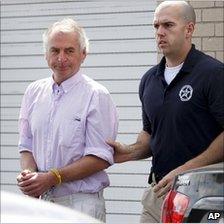Australia 'collar-bomb' suspect detained in US
- Published

Mr Peters made a brief appearance at the federal courthouse in Louisville
An Australian man is being held in the US state of Kentucky on charges he locked a fake bomb around the neck of a Sydney teenager in an extortion bid.
Paul Douglas Peters, 50, was detained pending extradition as startling details emerged about 18-year-old Madeleine Pulver's ordeal on 3 August.
Australian and US investigators traced him through an email account he hoped to use in ransom demands, police said.
A lawyer for Mr Peters said his client would fight the charges against him.
He was arrested on Monday at his ex-wife's house near Louisville, Kentucky, following a short but intensive investigation spanning two continents.
A chain of evidence based on forensic computer clues, transnational banking records and immigration records, among other things, traced his movement from the Australian state of New South Wales to the US, prosecutors said.
'I can see you'
In a federal court in Louisville on Tuesday, US Magistrate Judge Dave Whalin ordered that Mr Peters be held in custody until his extradition hearing on 14 October.
Police struggled for 10 hours to free Madeleine Pulver from the device
Ms Pulver was studying in her bedroom at her home in Mosman, near Sydney, on 3 August when a man wearing a balaclava and carrying a black box and a black baseball bat walked in about 14:30 local time, according to the criminal complaint .
Ms Pulver tried to flee but the man warned her to "sit down and no-one needs to get hurt", then placed the box around her neck and locked it with a device similar to a bicycle chain, the court document states.
Also locked on to the chain was a USB flash drive and a plastic document sleeve, the court document states.
The man then left, telling Ms Pulver: "Count to 200... I'll be back... if you move I can see you, I'll be right here," she told authorities.
Ms Pulver was "extremely frightened" and thought the man was robbing her house, the court filing states.
She eventually looked in the document sleeve and found a note saying the box contained explosives and warning her not to call police.
'Hysterical'
The note instructed her to send an email to a specified Gmail account, upon which she would be given ransom instructions.
She telephoned her parents, and police arrived soon afterwards to find her "crying and hysterical".
Bill Pulver: ''We are enormously relieved that an arrest has been made''
Over the next 10 hours, Ms Pulver remained in her room as police bomb technicians examined and x-rayed the box locked to her neck. They eventually determined it contained no explosives, then removed it. Ms Pulver was taken to hospital.
Ms Pulver described the man to police as being in his 60s, of medium build, with a "slightly protruding stomach" and weathered skin, the court document states.
Investigators began by discovering the Gmail account listed in the note was established from a computer at a Chicago airport on 30 May.
Police in New South Wales then interviewed witnesses at locations where the Gmail account was later accessed.
A review of CCTV footage and motor vehicle records led them to suspect Mr Peters of involvement.
Ex-wife's shock
Immigration records showed Mr Peters had flown through Chicago on 30 May, putting him at the airport when the Gmail account was created from a computer there, the court filing said.
Investigators also discovered Mr Peters had purchased a black baseball bat a few weeks before the encounter with Ms Pulver, it said.
Using bank records and other evidence, they traced Mr Peters to the Kentucky residence of his ex-wife, where he was arrested.
US prosecutors said only that Mr Peters had been employed by a company "with which the victim's family has links".
Mr Peters' lawyer Scott Cox said on Tuesday the suspect was a lawyer and investment banker who owns a company in Australia, the Associated Press news agency reported.
Mr Peters and his ex-wife Debra Peters, who sat through Tuesday's court hearing in tears, divorced in 2007 and have three children together, Mr Cox said.
"She's in shock," Mr Cox said of Ms Peters. "This is hard on her and her children. ... She's not involved in any respect to this, at all."
- Published5 August 2011
- Published4 August 2011
- Published4 August 2011
- Published4 August 2011